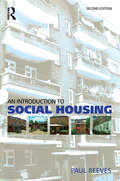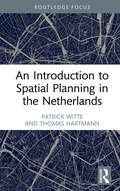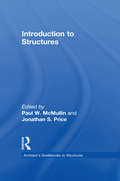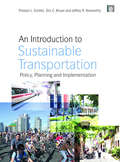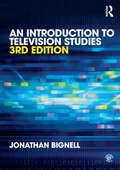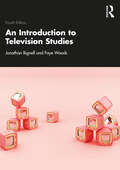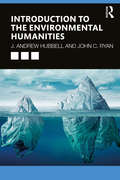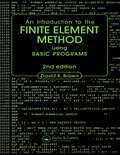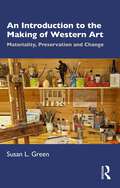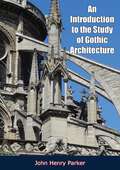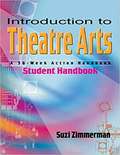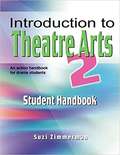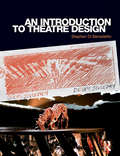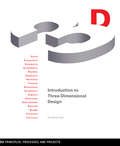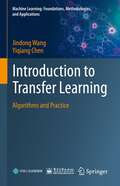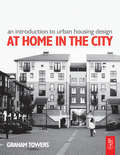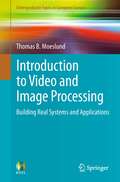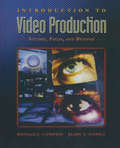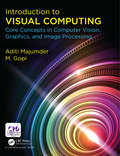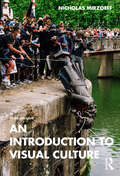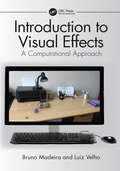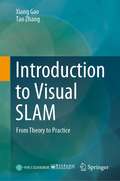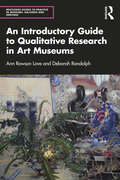- Table View
- List View
Introduction to Social Housing
by Paul ReevesThe provision and management of social housing for those who are unable to access the housing market is essential to the maintenance of the fabric of society. The social housing industry is vast and still growing. There are very few countries in the world where some form of subsidised housing does not exist, and the total number of social homes is likely to grow worldwide, as are the challenges of the sector.Paul Reeves takes a people-centred approach to the subject, describing the themes that have run through provision of social housing from the first philanthropic industrialists in the 19th Century though to the increasingly complex mixture of ownerships and tenures in the present day. The management of housing forms a key part of the book, with an emphasis on the practical aspects of tenant participation and multi-agency working.The book is ideal for students of housing and social policy, and for housing professionals aiming to obtain qualifications and wanting a broad understanding of the social housing sector.
An Introduction to Spatial Planning in the Netherlands
by Patrick Witte Thomas HartmannThis book provides an introduction to spatial planning in the Netherlands. It explores the academic underpinnings of the discipline and its practical implications, making use of insights on planning practices from the Netherlands. As an academic book with relevance for spatial planning teaching and practice, the relation between planning practice and planning as an academic discipline are discussed. A key analytical concept is introduced to discuss the different dimensions of planning: the planning triangle. This framework helps to bridging the strategic and conceptual elements of planning with its realization. The object, process and context of planning and its relations are discussed. The core of the academic discipline and profession of spatial planning entails looking (far) into the future, stimulating discussion, formulating a desired future direction through an informal and collective planning process and then formalizing and placing current action into that future perspective. In that sense, spatial planning can be understood as the strategic organisation of hopes and expectations. As a study book it is suitable for students of planning at various universities, but also for students in higher professional education. For those involved in the professional field of spatial planning, this book offers a sound foundation.
Introduction to Structures (Architect's Guidebooks to Structures #1)
by Paul W. McMullin Jonathan S. PriceIntroduction to Structures - the lead book in the Architect’s Guidebook to Structures series - presents structures in simple, accessible fashion through beautiful illustrations, worked examples, and from the perspective of practicing professionals with a combined experience of over 75 years. It introduces the student to, and reminds the practitioner of, fundamental structural design principles. Beginning by introducing structural forms in nature and history, the process of design, and selecting structural systems and materials, the book then moves onto statics, mechanics of materials, and structural analysis. The final chapter provides guidance on preliminary structural design, complete with decision criteria and design tables. Edited by experienced professional structural engineers, with vital contributions from practicing architects, Introduction to Structures is fully illustrated, contains clear step by step examples and preliminary design guidance. Designed as a key textbook for introductory structures courses, it is also an indispensable reference for practicing architects.
An Introduction to Sustainable Transportation: Policy, Planning and Implementation
by Preston L. Schiller Jeffrey R. KenworthyTransportation plays a substantial role in the modern world; it provides tremendous benefits to society, but it also imposes significant economic, social and environmental costs. Sustainable transport planning requires integrating environmental, social, and economic factors in order to develop optimal solutions to our many pressing issues, especially carbon emissions and climate change. This essential multi-authored work reflects a new sustainable transportation planning paradigm. It explores the concepts of sustainable development and sustainable transportation, describes practical techniques for comprehensive evaluation, provides tools for multi-modal transport planning, and presents innovative mobility management solutions to transportation problems. Students of various disciplines, planners, policymakers and concerned citizens will find many of its provocative ideas and approaches of considerable value as they engage in the processes of understanding and changing transportation towards greater sustainability. This text reflects a fundamental change in transportation decision making. It focuses on accessibility rather than mobility, emphasizes the need to expand the range of options and impacts considered in analysis, and provides practical tools to allow planners, policy makers and the general public to determine the best solution to the transportation problems facing a community. The book starts by placing transportation within the broader sustainability discussion, emphasising a comprehensive approach to sustainability planning and introducing the notion of 'regenerative transportation'. In sections on policymaking and planning the book examines how decisions are currently, and how they should be, made - explaining the complex and often misunderstood area of public participation. The authors explain demand management as applied to transportation and present lessons from other public arenas and areas of application, especially in urban-suburban areas. The text takes readers through each and every mode of transport, beginning with human-powered modes and ending in motorized modes, including marine and air transport. The modes are analyzed separately and in comparison with others according to several criteria: Capacity/utility/functionality considerations; infrastructure demands; resource consumption; land use considerations; pollution; and costs. In ways that non-technically trained readers as well as planning students professionals can find useful the book includes guidance on how to optimize transportation systems; balancing economic, social and environmental objectives while creating just, robust, and diverse, rather than one-size-fits-all, solutions. The modes are grouped and compared within their respective contexts, and there is vital discussion and differentiation between passenger and freight-goods transport. The final section develops a comprehensive summary of the previous chapters and develops arguments for sustainable transportation policymaking and integrated planning, providing international examples and case studies and extracting from them general applications for integrated sustainable transportation. Featuring extensive international examples and case-studies, textboxes, graphics, recommended reading and end of chapter questions, the authors draw on considerable teaching and researching experience to present an essential, ground-breaking and authoritative text on sustainable transport.
An Introduction to Television Studies
by Jonathan BignellIn this comprehensive textbook, now updated for its third edition, Jonathan Bignell provides students with a framework for understanding the key concepts and main approaches to Television Studies, including audience research, television history and broadcasting policy, and the analytical study of individual programmes. Features include: a glossary of key terms key terms defined in margins suggestions for further reading activities/assignments for use in class New and updated case studies feature: ‘Every Home Needs a Harvey’ ad approaches to news reporting television scheduling CSI Crime Scene Investigation animated cartoon series Individual chapters address: studying television, television histories, television cultures, television texts and narratives, television genres and formats, television production, television and quality, television realities, television you can’t see, television audiences, beyond television.
An Introduction to Television Studies
by Jonathan Bignell Faye WoodsThis comprehensive textbook, now substantially updated for its fourth edition, provides students with a framework for understanding the key concepts and main approaches to Television Studies, including audiences, representation, industry and global television, as well as the analytical study of individual programmes. This new edition reflects the significant changes the television industry is undergoing in the streaming era with an explosion of new content and providers, whilst also identifying how many existing practices have endured. The book includes a glossary of key terms, with each chapter suggesting further reading. New and updated material includes: Chapters on style and form, narrative, industry, and representation and identity Case studies on Bon Appétit’s YouTube channel, Insecure, British youth television, ABC and Disney+, fixed-rig observational documentary, streaming platforms' use of data to shape audience experience, Chewing Gum, Korean drama and The Marvelous Mrs Maisel Sections on medical drama, YouTube creators, Skam and scripted format sales, the global spread of streaming platforms, prestige TV and period drama With individual chapters addressing television style and form, narrative, histories, industries, genres and formats, realities, production, audiences, representation and identity, and quality, this book is essential reading for both students and scholars of Television Studies.
Introduction to the Environmental Humanities
by J. Andrew Hubbell John C. RyanIn an era of climate change, deforestation, melting ice caps, poisoned environments, and species loss, many people are turning to the power of the arts and humanities for sustainable solutions to global ecological problems. Introduction to the Environmental Humanities offers a practical and accessible guide to this dynamic and interdisciplinary field. This book provides an overview of the Environmental Humanities’ evolution from the activist movements of the early and mid-twentieth century to more recent debates over climate change, sustainability, energy policy, and habitat degradation in the Anthropocene era. The text introduces readers to seminal writings, artworks, campaigns, and movements while demystifying important terms such as the Anthropocene, environmental justice, nature, ecosystem, ecology, posthuman, and non-human. Emerging theoretical areas such as critical animal and plant studies, gender and queer studies, Indigenous studies, and energy studies are also presented. Organized by discipline, the book explores the role that the arts and humanities play in the future of the planet. Including case studies, discussion questions, annotated bibliographies, and links to online resources, this book offers a comprehensive and engaging overview of the Environmental Humanities for introductory readers. For more advanced readers, it serves as a foundation for future study, projects, or professional development.
Introduction to the Finite Element Method using BASIC Programs
by D.K. BrownThis updated, revised and extended edition gives a comprehensive introduction to the understanding and use of the finite element method as applied to structures. The text methodically covers all the important bridges in understanding up to and including the introduction of isoparametric elements.
An Introduction to the Making of Western Art: Materiality, Preservation and Change
by Susan L. GreenThis book is the first introduction to Western art that not only considers how choice of materials can impact form, but also how objects in different media can alter in appearance over time, and the role of conservators in the preservation of our cultural heritage.The first four chapters cover wall and easel paintings, sculpture, drawings, and prints, from the late Middle Ages to the present day. They examine, with numerous examples, how these works have been produced, how they might have been transformed, and how efforts regarding their preservation can sometimes be misleading or result in controversy. The final two chapters look at how photography, new techniques, and modern materials prompted innovative ways of creating art in the twentieth century, and how the rapid expansion of technology in the twenty-first century has led to a revolution in how artworks are constructed and seen, generating specific challenges for collectors, curators, and conservators alike.This book is primarily directed at undergraduates interested in art history, museum studies, and conservation, but will also be of interest to a more general non-specialist audience.
An Introduction to the Philosophy of Art
by Richard EldridgeRichard Eldridge's compact survey of philosophical theories of the nature and significance of art draws on materials from classical and contemporary philosophy as well as literary theory and art criticism. Eldridge explores the representational, expressive, and formal dimensions of art, and argues that works of art present their subject matter as creations of enduring cognitive, moral, and social interest. His accessible study will be of interest to students and anyone interested in the relationship between thought and art.
An Introduction to the Study of Gothic Architecture
by John Henry ParkerThis popular and important textbook of Gothic architecture, first published in 1849, which ran to at least sixteen editions. The book is divided into the main body of the text, with mostly English examples of the various periods, and a section on foreign styles (French Gothic, Italian, Spanish, Swiss, Belgian, German).-Print ed.John Henry Parker CB (1 March 1806 – 31 January 1884) was an English archaeologist and writer on architecture and publisher.He was born in London, the son of John Parker, a merchant there. He was educated at Manor House School, Chiswick, and was apprenticed in 1821 to his uncle, the Oxford bookseller Joseph Parker (1774?–1850). He succeeded to his uncle's business in 1832, and ran the firm with great success, the most important of his publications being perhaps the series of the Oxford pocket classics.In 1836 he published his Glossary of terms used in Grecian, Roman, Italian, and Gothic architecture, which, published during the Gothic Revival in England, had considerable influence in extending the movement, and supplied valuable inspiration to young architects. In 1848 he edited the fifth edition of Thomas Rickman's Gothic architecture, and in 1849 he published a handbook based on his earlier volume entitled Introduction to the study of Gothic architecture. The completion of Hudson Turner's Domestic architecture of the Middle Ages next engaged his attention, three volumes being published (1853–60). He published Medieval architecture of Chester in 1858 and Architectural antiquities of the city of Wells in 1866.Parker was one of the chief advocates of the restoration of ecclesiastical buildings. In 1863 he and the Oxford Diocesan Architect G.E. Street revised plans for the restoration of St. Andrew's parish church, Chinnor. Parker also designed the triplet of traceried lancet windows in the chancel of St. Nicholas the Confessor, Forest Hill. His son James Parker (1832 or 1833–1912) also practiced as an architect.
Introduction to Theatre Arts: A 36-Week Action Handbook
by Suzi ZimmermanAt last! A student-friendly, teacher-friendly workbook with study units for a full year of classroom drama activities. <p><p> The entire spectrum of theatre is covered in ten sections: 1. Getting Started, 2. Evaluation, 3. Scene Work, 4. Acting, 5. Characterization, 6. Publicity and Other Production Business, 7. Play Production, 8. Theatre History, 9. Games and Improvisation, 10. Planning for the Future. All units are complete with detailed instructions, examples, working forms, and photo illustrations. Students will learn all the basics of theatre history, play production, performing, and finding a career in theatre. This instructional program is classroom-tested and designed to fit the budgetary considerations of schools.
Introduction to Theatre Arts 2: An Action Handbook for Drama Students
by Suzi ZimmermanThose who have already discovered the ease of teaching Theatre Arts with Suzi Zimmerman's first textbook will be thrilled to learn she has come out with this sequel! <p><p> This action handbook takes all the outstanding components you loved in the first book and applies it to seven new sections: 1. Theatre for Life s Lessons, 2. Movement Theatre for the Eyes, 3. Voice Theatre for the Ears, 4. Skill-Building Activities Theatre Projects, Mini-Units and Self-Guided Lessons, 5. Understanding and Writing Scripts, 6. Theatre Behind the Scenes, and 7. Production 101. Theory combined with hands-on is the style of every chapter. This series has been classroom-tested to fit the budgetary considerations of all schools.
An Introduction to Theatre Design
by Stephen Di BenedettoThis introduction to theatre design explains the theories, strategies, and tools of practical design work for the undergraduate student. Through its numerous illustrated case studies and analysis of key terms, students will build an understanding of the design process and be able to: identify the fundamentals of theatre design and scenography recognize the role of individual design areas such as scenery, costume, lighting and sound develop both conceptual and analytical thinking Communicate their own understanding of complex design work trace the traditions of stage design, from Sebastiano Serlio to Julie Taymor. Demonstrating the dynamics of good design through the work of influential designers, Stephen Di Benedetto also looks in depth at script analysis, stylistic considerations and the importance of collaboration to the designer's craft. This is an essential guide for students and teachers of theatre design. Readers will form not only a strong ability to explain and understand the process of design, but also the basic skills required to conceive and realise designs of their own.
Introduction to Three-Dimensional Design: Principles, Processes, and Projects (Design Brief Ser.)
by Kimberly ElamIntroduction to Three-Dimensional Design is the first book to teach graphic design students the fundamentals of three-dimensional design through hands-on drawing and model projects. The book combines key concepts with carefully crafted exercises so students can apply three-dimensional design principles in practice. From initial sketches through experimental prototypes to the final model solutions, students will develop a deeper understanding of the often complex elements and principles of three-dimensional design.
Introduction to Transfer Learning: Algorithms and Practice (Machine Learning: Foundations, Methodologies, and Applications)
by Jindong Wang Yiqiang ChenTransfer learning is one of the most important technologies in the era of artificial intelligence and deep learning. It seeks to leverage existing knowledge by transferring it to another, new domain. Over the years, a number of relevant topics have attracted the interest of the research and application community: transfer learning, pre-training and fine-tuning, domain adaptation, domain generalization, and meta-learning. This book offers a comprehensive tutorial on an overview of transfer learning, introducing new researchers in this area to both classic and more recent algorithms. Most importantly, it takes a “student’s” perspective to introduce all the concepts, theories, algorithms, and applications, allowing readers to quickly and easily enter this area. Accompanying the book, detailed code implementations are provided to better illustrate the core ideas of several important algorithms, presenting good examples for practice.
Introduction to Urban Housing Design: At Home In The City
by Graham TowersThis clear and concise guide is the ideal introduction to contemporary housing design for students and professionals of architecture, urban design and planning. With the increasing commitment to sustainable design and with an ever-increasing demand for houses in urban areas, housing design has taken on a new and crucial role in urban planning. This guide introduces the reader to the key aspects of housing design, and outlines the discussion about form and planning of urban housing. Using chapter summaries and with many illustrations, it presents contemporary concerns such as energy efficient design and high density development in a clear and accessible way. It looks at practical design solutions to real urban problems and includes advice on reclamation and re-use of buildings. The guidance it presents is universally relevant. Part two of the book features current case studies that illustrate the best in high density, sustainable housing design providing the reader with design information, and design inspiration, for their own projects.
Introduction to Video and Image Processing
by Thomas B. MoeslundThis textbook presents the fundamental concepts and methods for understanding and working with images and video in an unique, easy-to-read style which ensures the material is accessible to a wide audience. Exploring more than just the basics of image processing, the text provides a specific focus on the practical design and implementation of real systems for processing video data. Features: includes more than 100 exercises, as well as C-code snippets of the key algorithms; covers topics on image acquisition, color images, point processing, neighborhood processing, morphology, BLOB analysis, segmentation in video, tracking, geometric transformation, and visual effects; requires only a minimal understanding of mathematics; presents two chapters dedicated to applications; provides a guide to defining suitable values for parameters in video and image processing systems, and to conversion between the RGB color representation and the HIS, HSV and YUV/YCbCr color representations.
Introduction to Video Production: Studio, Field, and Beyond
by Ronald Compesi Jaime GomezWritten in a clear, non-technical manner, Introduction to Video Production focuses on the fundamental principles of video production and the technologies used in production. This book discusses video aesthetics, technologies, and production practice in a clear and concise manner. It also emphasizes the importance of teamwork and planning in the production process. Chapters are clearly organized and heavily illustrated, with key terms identified in boldface. With Introduction to Video Production, readers will learn not only how the technology works, but how to work with the technology and with each other.
Introduction to Video Production: Studio, Field, and Beyond
by Ronald J. Compesi Jaime S. GomezWritten in a clear, non-technical manner, Introduction to Video Production focuses on the fundamental principles and aesthetics of video production and the technologies used in both studio and field environments. Ronald J. Compesi and Jaime S. Gomez cover each aspect of the process step by step, from preproduction to lighting, sound, directing, editing, graphics, and distribution. Taking into account the changes in workflow and production planning and distribution brought on by the advent of digital media, this second edition has been updated throughout to account for the increasing popularity of DSLR cameras, online distribution, the rise of portable cameras and mobile video, and much more. Key features include: a thorough overview of video production in studio and field environments without being overly technical, allowing students to get the "big picture" of production; coverage of new digital production, recording, and editing technologies; over 300 photos and line art illustrating aesthetic elements, technical issues, and production planning; key words identified in boldface throughout the text and reinforced in a comprehensive glossary of terms.
Introduction to Visual Computing: Core Concepts in Computer Vision, Graphics, and Image Processing
by Aditi Majumder M. GopiIntroduction to Visual Computing: Core Concepts in Computer Vision, Graphics, and Image Processing covers the fundamental concepts of visual computing. Whereas past books have treated these concepts within the context of specific fields such as computer graphics, computer vision or image processing, this book offers a unified view of these core concepts, thereby providing a unified treatment of computational and mathematical methods for creating, capturing, analyzing and manipulating visual data (e.g. 2D images, 3D models). Fundamentals covered in the book include convolution, Fourier transform, filters, geometric transformations, epipolar geometry, 3D reconstruction, color and the image synthesis pipeline. The book is organized in four parts. The first part provides an exposure to different kinds of visual data (e.g. 2D images, videos and 3D geometry) and the core mathematical techniques that are required for their processing (e.g. interpolation and linear regression.) The second part of the book on Image Based Visual Computing deals with several fundamental techniques to process 2D images (e.g. convolution, spectral analysis and feature detection) and corresponds to the low level retinal image processing that happens in the eye in the human visual system pathway. The next part of the book on Geometric Visual Computing deals with the fundamental techniques used to combine the geometric information from multiple eyes creating a 3D interpretation of the object and world around us (e.g. transformations, projective and epipolar geometry, and 3D reconstruction). This corresponds to the higher level processing that happens in the brain combining information from both the eyes thereby helping us to navigate through the 3D world around us. The last two parts of the book cover Radiometric Visual Computing and Visual Content Synthesis. These parts focus on the fundamental techniques for processing information arising from the interaction of light with objects around us, as well as the fundamentals of creating virtual computer generated worlds that mimic all the processing presented in the prior sections. The book is written for a 16 week long semester course and can be used for both undergraduate and graduate teaching, as well as a reference for professionals.
An Introduction to Visual Culture
by Nicholas MirzoeffIn the fully rewritten third edition of this classic text, Nicholas Mirzoeff introduces visual culture as visual activism, or activating the visible. In this view, visual culture is a practice: a way of doing, making, and seeing. The 12 new chapters begin with five foundational concepts, including Indigenous ways of seeing, visual activism in the wake of slavery, and unfixing the gaze. The second section outlines three currently successful tactics of visual activism: removal of statues and monuments; restitution of cultural property; and practices of repair and reparations. The final section addresses catastrophe and trauma, from Palestine’s Nakba to the climate disaster and the intersections of plague and war. Each section also includes new, in-depth case studies called "Visualizations," ranging from oil painting to Kongo power figures and the mediated practice of taking a knee. Engaging with questions of racializing, colonialism, and undoing gender throughout, this edition maps the activist turn in the field since 2014 and sets directions for its future expansion. This is a key text in visual culture studies and an essential resource for research and teaching in the field.
Introduction to Visual Effects: A Computational Approach
by Bruno Madeira Luiz VelhoIntroduction to Visual Effects: A Computational Approach is the first single introduction to the computational and mathematical aspects of visual effects, incorporating both computer vision and graphics. The book also provides the readers with the source code to a library, enabling them to follow the chapters directly and build up a complete visual effects platform. The book covers the basic approaches to camera pose estimation, global illumination, and image-based lighting, and includes chapters on the virtual camera, optimization and computer vision, path tracing and many more. Key features include: Introduction to projective geometry, image-based lighting (IBL), global illumination solved by the Monte Carlo method (Pathtracing), an explanation of a set of optimization methods, and the techniques used for calibrating one, two, and many cameras, including how to use the RANSAC algorithm in order to make the process robust, and providing code to be implemented using the Gnu Scientific Library. C/C++ code using the OpenCV library, to be used in the process of tracking points on a movie (an important step for the matchmove process), and in the construction of modeling tools for visual effects. A simple model of the Bidirectional Reflectance Distribution Function (BRDF) of surfaces and the differential rendering method, allowing the reader to generate consistent shadows, supported by a code that can be used in combination with a software like Luminance HDR.
Introduction to Visual SLAM: From Theory to Practice
by Xiang Gao Tao ZhangThis book offers a systematic and comprehensive introduction to the visual simultaneous localization and mapping (vSLAM) technology, which is a fundamental and essential component for many applications in robotics, wearable devices, and autonomous driving vehicles. The book starts from very basic mathematic background knowledge such as 3D rigid body geometry, the pinhole camera projection model, and nonlinear optimization techniques, before introducing readers to traditional computer vision topics like feature matching, optical flow, and bundle adjustment. The book employs a light writing style, instead of the rigorous yet dry approach that is common in academic literature. In addition, it includes a wealth of executable source code with increasing difficulty to help readers understand and use the practical techniques. The book can be used as a textbook for senior undergraduate or graduate students, or as reference material for researchers and engineers in related areas.
An Introductory Guide to Qualitative Research in Art Museums (Routledge Guides to Practice in Museums, Galleries and Heritage)
by Ann Rowson Love Deborah RandolphAn Introductory Guide to Qualitative Research in Art Museums is a practice-based guide that is designed to introduce qualitative research to established and upcoming museum professionals and increase their confidence to conduct this type of research. Highlighting the work of researchers who are studying museums around the world, the book begins by explaining why there is a need for qualitative research in museums. Rowson Love and Randolph then go on to provide guidance, including theories and frameworks, on how to envision a qualitative research project that facilitates meaningful interpretation of visitor experiences. Chapters in the methodology section begin with descriptions of featured qualitative methodologies and will assist readers as they determine which are most appropriate for their projects and as they advocate for their research. The final section will prepare readers still further by demonstrating data analysis and reporting using the examples in the book. An Introductory Guide to Qualitative Research in Art Museums will help museum professionals and students engaged in the study of museums expand their repertoire to include qualitative methodologies and explain the methods needed to conduct, analyze, and report their qualitative research. It will be particularly useful to those with an interest in museum education, visitor studies and audience research, exhibition development, leadership, and management.
